Verdict
It may not look that different from its predecessor on the surface, but a host of upgrades to display tech, processing power and even water resistance make the Galaxy Tab S9 one of the most capable Android tablets on the market, and unlike the more premium S9 Plus and S9 Ultra, it remains relatively compact.
Pros
- Most portable of Samsung’s Tab S9 range
- Stunning 11-inch Dynamic AMOLED 2X screen
- IP68 dust and water resistance
- S Pen is bundled with the tablet
Cons
- Thicker bezels than the Tab S9 Ultra
- Only a single selfie camera
- No charger in the box
-
11-inch displayThe Dynamic AMOLED 2X screen with a 120Hz refresh rate delivers a top-notch viewing experience. -
Snapdragon 8 Gen 2 for Galaxy processing powerWith a custom flagship Qualcomm processor under the hood, the Tab S9 is comfortably more powerful than most Android tablet alternatives. -
8,400 mAh batteryIt may be the smallest in the Galaxy Tab S9 line, but you couldn’t tell from the excellent battery life.
Introduction
While the Android tablet market is a little hit-and-miss, Samsung delivers consistently high-quality Android tablets in the form of its Tab S series, and the Galaxy Tab S9 continues that trend.
The Tab S9 boasts key upgrades over its predecessor including a jump from IPS LCD display tech to the much more luxurious Dynamic AMOLED 2X, and the Snapdragon 8 Gen 2 for Galaxy processing power that makes it one of the most powerful Android tablets around.
Plus, the 11-inch display is the sweet spot for portability in Samsung’s latest collection, with a more compact build than the 12.4-inch Tab S9 Plus and the frankly massive 14.6-inch Tab S9 Ultra.
The only question is, then, is it worth getting the Galaxy Tab S9 over one of Apple’s premium iPads? Here are my thoughts.
Design
- Similar overall look to its predecessor
- New IP68 dust and water resistance
- Relatively thin and portable
The Samsung Galaxy Tab S9 looks a whole lot like the Tab S8, which is to say that it’s the same blend of glass and aluminium that we’ve seen from most tablets over the past few years. There’s nothing wrong with that of course – if it ain’t broke, don’t fix it – but it’s one less reason for Tab S8 owners to upgrade.
To Samsung’s credit, this is an especially sleek-looking tablet with an aluminium frame and rear and angular edges that make it not look too dissimilar to one of Apple’s recent premium iPads. It’s also pretty lightweight for a tablet of this size at 498g, and at 5.9mm thick, it’s relatively thin too.
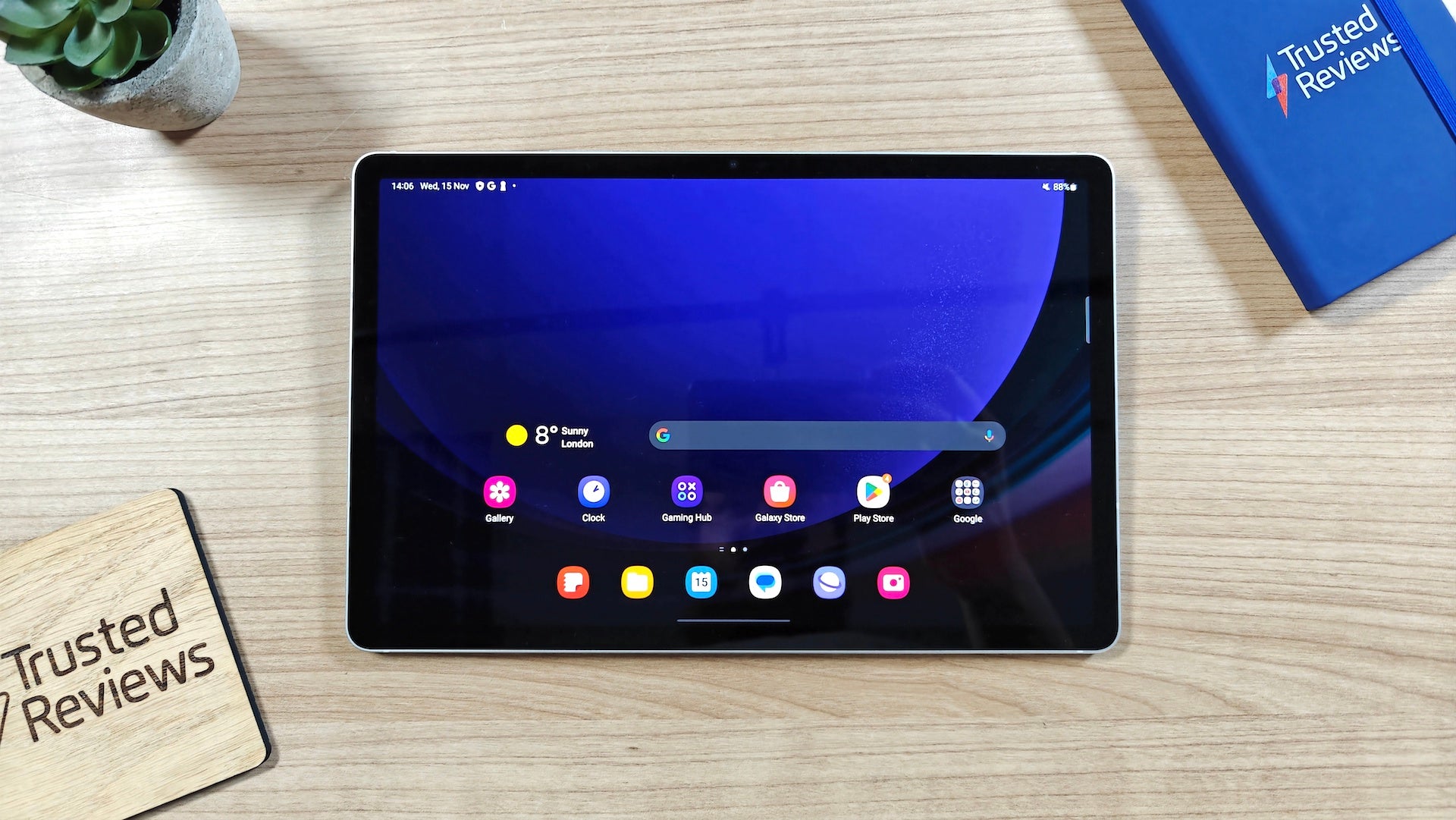
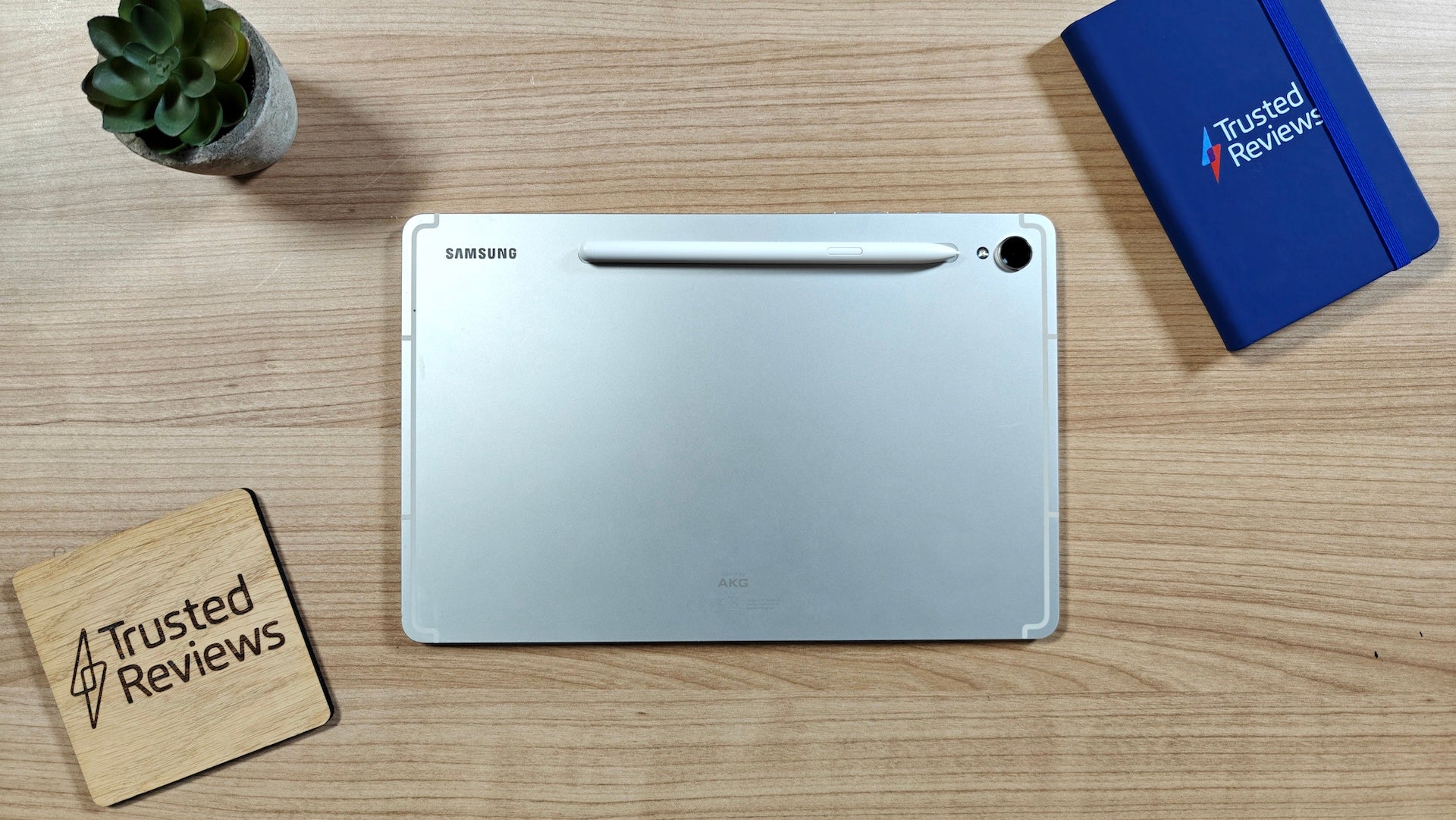
This all translates to a tablet that’s both easy to hold and easy to store in a rucksack without taking up too much space.
In portrait orientation, there’s a USB-C port and twin speakers at the bottom, along with two more at the top for a stereo experience, with the power button and volume controls along the right-hand side.
However, the Tab S9 isn’t designed for portrait use, as evidenced by the selfie camera housed within the longer edge of the tablet. That means it’s best used in a horizontal position, where it’s centrally placed and ideal for video calls.
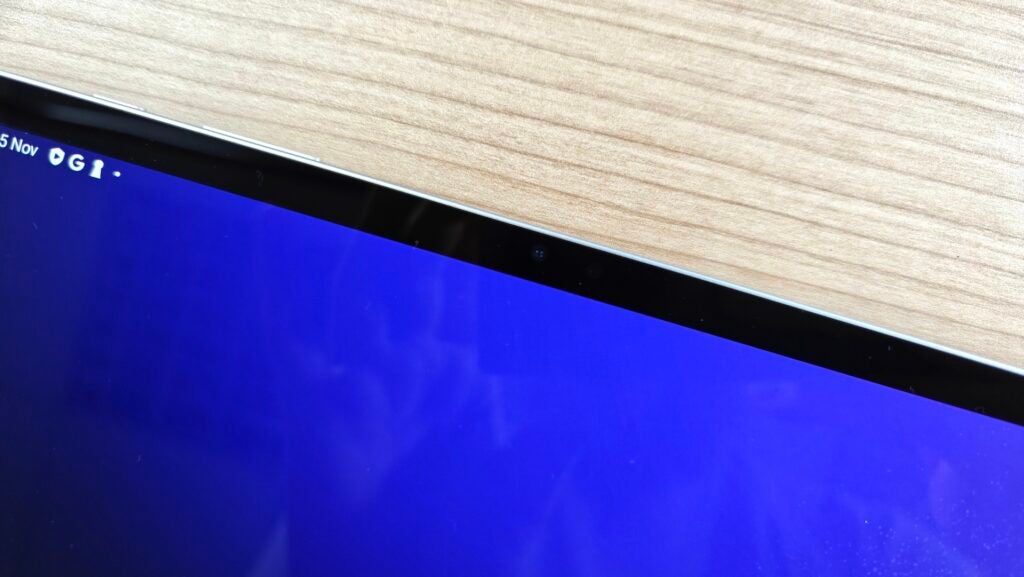
One element of the Tab S9’s design that is new is IP68 dust and water resistance, making it the only tablet on the market to offer such high levels of protection. The added peace of mind is welcome, although you still won’t catch me using the tablet at the beach.
One huge benefit of the Tab S9 compared to Apple’s iPad collection is that the S Pen stylus comes in the box, completely free of charge.
It proves to be a practical companion too, allowing for doodling and quick note-taking on the 11-inch display, even when it’s turned off. Its compatibility with apps like Goodnotes adds to its versatility, and the built-in pen doubles up as a camera shutter for group selfies.
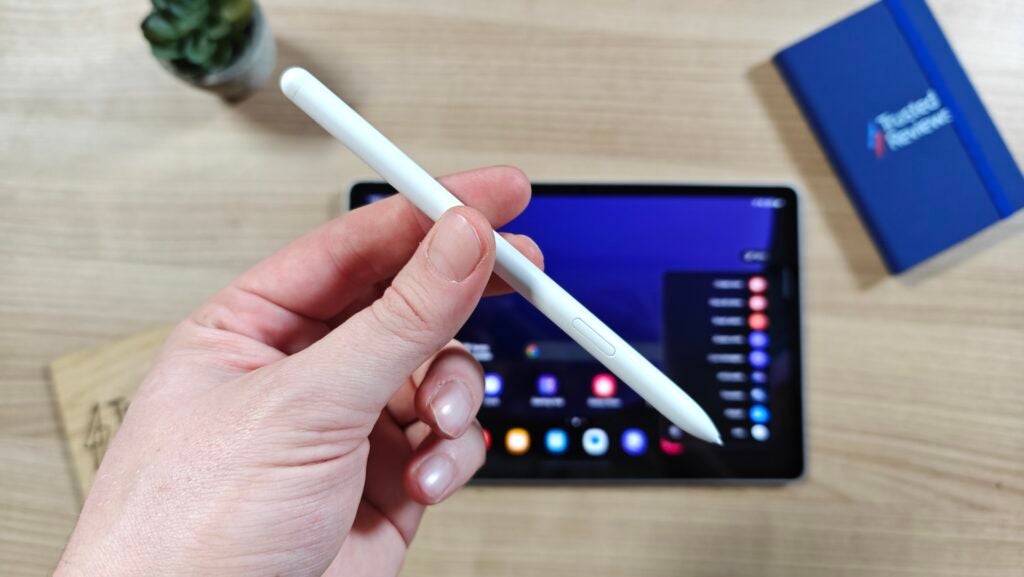
It’s not just handy either, with an impressive 2.8ms response time that outshines even Apple’s top-end Apple Pencil 2 by quite some way. It’s still not the pen-and-paper experience you’ll find from the likes of the ReMarkable 2, but it comes pretty close.
My only real complaint is the charging system; the pen is designed to magnetically attach to the rear of the tablet for storage and charging. But this means it’s easy for the pen to come dislodged when put in a rucksack, as happened several times during the review period, and it means the tablet doesn’t sit flat on the table with the pen docked either.
Screen
- 11-inch Dynamic AMOLED 2X display
- Stunning HDR performance
- Smooth 120Hz refresh rate
The regular Samsung Galaxy Tab S9 sports an 11-inch display that I feel is the sweet spot in the Tab S9 collection, with a more easily portable size than the likes of the 12.4-inch Tab S9 Plus and the behemoth that is the 14.6-inch Tab S9 Ultra. It makes it easier to hold and use, and facilitates comfortable use lying in bed too.
That doesn’t make it any less useful for the bundled S Pen either; I found the 11-inch slate to be more than sizable enough for note-taking, doodling and the like.
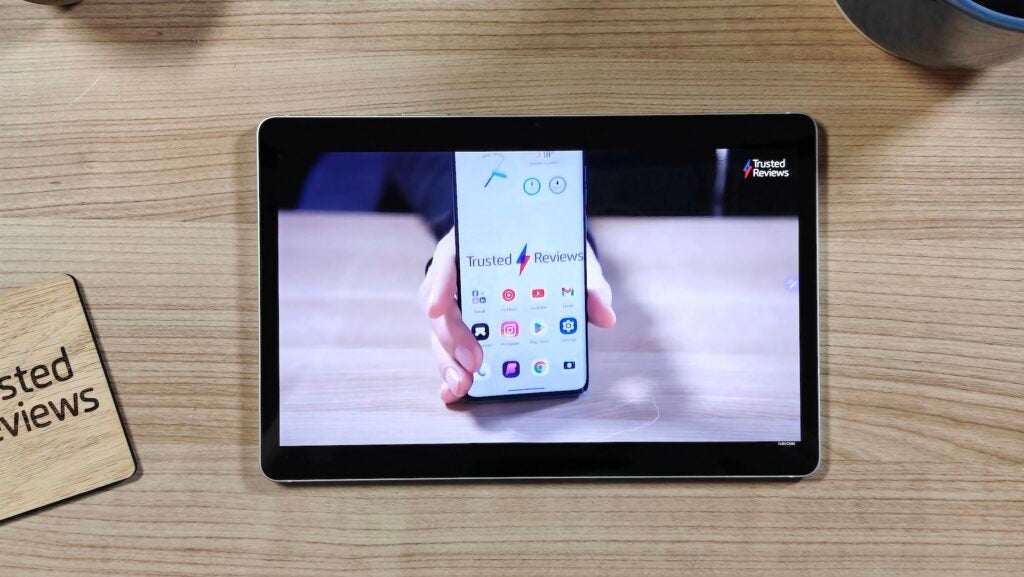
Dimensions aside, you might struggle to tell the difference between the Tab S8 and newer Tab S9 – until you turn the display on, that is.
That’s because the Tab S9 boasts Samsung’s Dynamic AMOLED 2X screen tech, a huge upgrade from the IPS LCD display of its predecessor. That means the Tab S9 is brighter, more vibrant and boasts inkier blacks than the comparatively grey hues of LCD tech, and that’s pretty much instantly noticeable.
That’s all a roundabout way of saying that the Tab S9’s display is absolutely stunning. It’s bright enough for comfortable outdoor use, even with a reflective screen, with vibrant colours that make David Attenborough’s Life in Colour look spectacular, especially when viewed in HDR with HDR10+ support onboard.
Other returning features include a 120Hz refresh rate that makes everything from swiping and scrolling to gaming feel that little bit smoother, with the ability to drop down to 60Hz to save battery life whenever possible. The ability to only drop down to 60Hz rather than 90Hz, 72Hz, etc is a little disappointing, though admittedly it isn’t noticeable in day-to-day use.
All in all then, this is a spectacularly premium 11-inch display with vibrant colours, plenty of detail and impressive HDR performance that’ll serve both binge-watching Netflix and gaming well.
Cameras
- Single 13MP rear camera
- 12MP selfie camera
- Fine performance but not a focus for Samsung
As impressive as the Tab S9 is, it doesn’t do much to further the camera experience on tablets – and for good reason. I mean, who actually wants to take photos on a tablet?
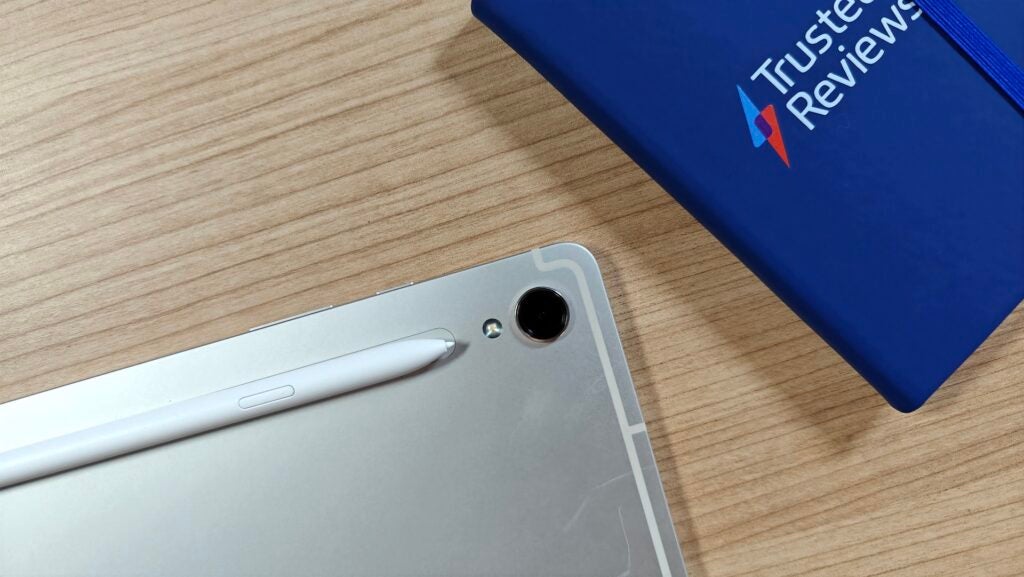
Samsung has gone all-in on a single 13MP primary camera on the rear, complete with an LED flash for good measure, along with a single 12MP snapper on the front.
Interestingly, selfie camera tech is one of the key areas where the Tab S9 differs from the top-end S9 Ultra, with Samsung’s top-end option offering dual main and ultrawide cameras to better accommodate large group video meetings or demonstrations.

As such, while the selfie camera of the Tab S9 does an admirable job of delivering detailed selfies for video chats, it doesn’t have the option to expand the view as much as the top-end tablet. How much this affects your video calls, however, will depend on what you’re doing. For most, it likely won’t be a dealbreaker.
Turning to the rear 13MP camera, expect a solid experience with decent detail and vibrant colours with photos taken in bright daylight, though don’t expect that to translate to low-light environments, lacking the wide aperture or pixel-binning tech required to capture light in darkness. Still, it’ll more than suffice for the occasional snap of a document for scanning or use in a mixed-reality app.
Video is equally restricted compared to Android smartphone alternatives, capped at 30fps regardless of whether you’re recording at 1080p or 4K.
Performance
- Snapdragon 8 Gen 2 for Galaxy
- 8- or 12GB of RAM
- Unparalleled Android tablet performance
The Samsung Galaxy Tab S9, along with the rest of the Tab S9 collection, boasts the title of the most powerful Android tablet on the market.
Why? It’s down to the inclusion of the same custom Snapdragon 8 Gen 2 for Galaxy chipset as the flagship Galaxy S23 range. Coupled with a whopping 8- or 12GB of RAM and up to 256GB of storage, it’s essentially an overclocked 8 Gen 2 with a higher CPU clock speed and an additional GPU core to eke out the very best performance possible from the chipset.
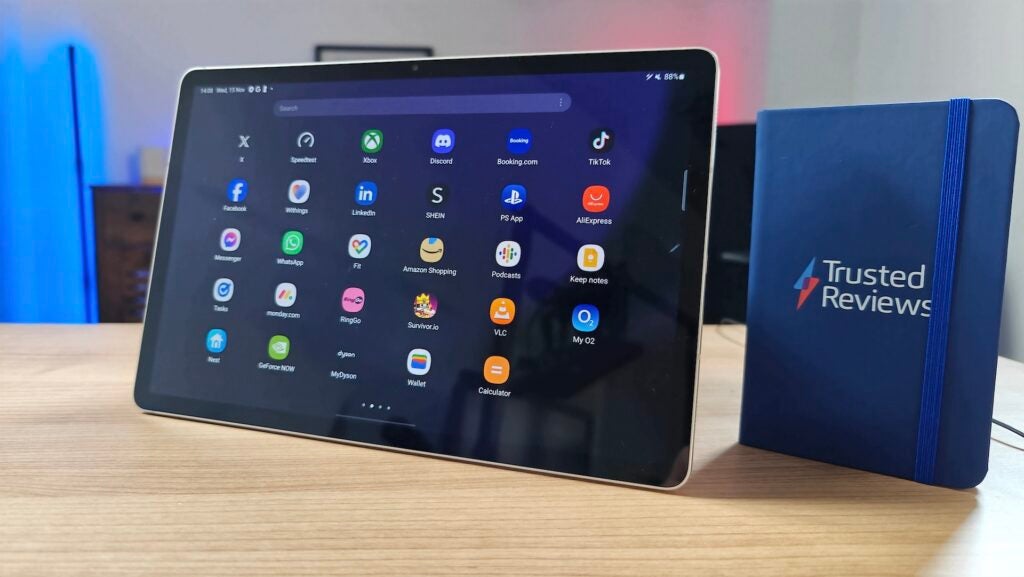
As a result, not even regular Snapdragon 8 Gen 2 Android tablets (of which there aren’t many, admittedly) can hold a candle to what the Galaxy Tab S9 can offer – something backed up by both real-world use and synthetic benchmark tests, the latter of which you can see the results of here:
It’s not quite as fast as the M2-enabled iPad Pro in benchmarks, but then again, no Android tablets are.
As for real-world use, the Tab S9 sailed through whatever I could think to throw at it. While it unsurprisingly handled basic tablet tasks like scrolling through Instagram and TikTok or browsing the web in Chrome with ease, it was also capable of high-end gaming.
I ran both Call of Duty Mobile and Diablo Immortal with top-end graphics enabled and had a solid 60fps experience across both, with no discernable lag or stuttering even after 30 minutes of gameplay. That top-end graphics performance should also translate to a speedy editing and rendering process for mobile creatives, though without access to LumaFusion, it’s not something I could personally test.

The chip is paired with other flagship-level components including Wi-Fi 6e and Bluetooth 5.3, and if you opt for the slightly more expensive cellular model, you’ll gain access to 5G connectivity too. The latter is a real boon as Apple’s iPads are yet to move to 5G, allowing for fast internet speeds that enable on-the-go work and even cloud gaming.
Software
- Android 13 with OneUI 5.2
- Notable tablet functionality
- Three OS upgrades on offer
The Samsung Galaxy Tab S9 comes with Android 13 running Samsung’s heavily customised OneUI 5.2 on top. The update to Android 14 is indeed planned, but at the time of writing, it’s yet to materialise on the flagship tablet.
So, with that said, what’s the OneUI 5.2 experience like on the Tab S9? It’ll likely depend on how familiar you are with Samsung smartphones and tablets, because it’s quite far from the stock Android experience you’ll find on the Google Pixel Tablet.
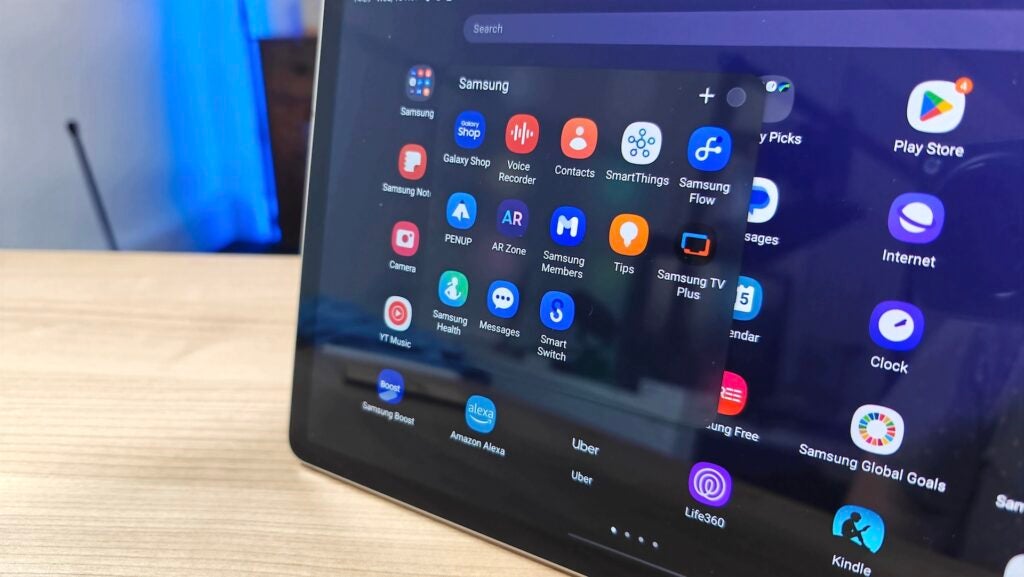
That’s evident in a number of ways, from the stylised notification shade to the sheer number of Samsung-branded app equivalents pre-loaded on the tablet, from Samsung Browser to Samsung Health, going as far as to remove some Google equivalents during a data transfer from another tablet. That’s a bit of a cheeky move there, Samsung.
It’ll likely take some getting used to if you’re not an avid Samsung fan, though it isn’t as painful as other skins like Honor’s MagicUI and Xiaomi’s EMUI. Everything still makes sense; it’s just laid out a little differently.
Thankfully, Samsung takes the tablet experience more seriously than other Android makers, with a handful of tablet-specific features on the Tab S9. That includes an iPad-esque toolbar at the bottom of the tablet that displays shortcuts to recently used apps, as well as the ability to launch the app launcher from anywhere within the OS – ideal for split-screen multitasking.
The split-screen multitasking capabilities can run two apps side-by-side with a third present in a floating window, taking your content consumption to the next level. But while the Snapdragon chipset can handle this with absolute ease, just how well an 11-inch panel handles displaying that many apps on screen compared to the 12.4-inch and 14.6-inch displays of the Tab S9 Plus and Tab S9 Ultra is debatable.
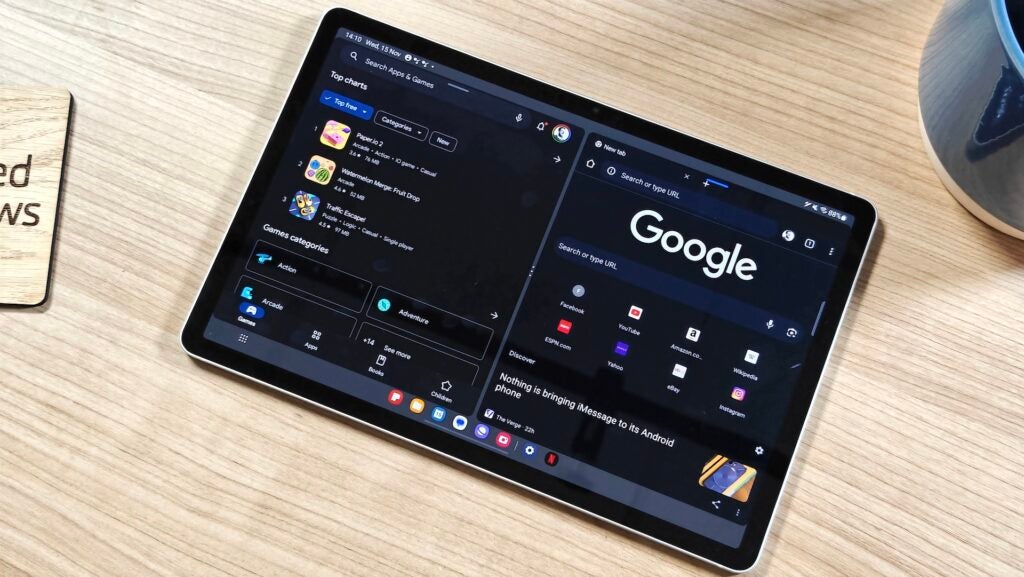
It hasn’t fixed one of the core issues with Android tablets in general, however. App support is still hit-and-miss among some popular Android apps, particularly when it comes to landscape aspect ratio support. As a result, some apps will look a little odd or outright refuse to be used in landscape mode.
Samsung should be praised for its long-term software promise. While its smartphone collection has recently been outdone by Google’s upgraded commitment to 7 OS upgrades with the Pixel 8, there’s no such promise in the land of tablets. That means that Samsung’s promise of four OS upgrades and five years of security patches are still among the best you’ll find on the Android market, taking the tablet through to Android 17.
Battery life
- 8400mAh battery
- Excellent battery life
- Fairly quick 45W charging
As you might expect from a big-screen tablet that can house a decently sized 8400mAh battery within its thin chassis, the Samsung Galaxy Tab S9 offers superb battery life that won’t leave many people wanting more.
Coupled with an energy-efficient display that can adjust its refresh rate depending on what you’re doing and the power-friendly Snapdragon 8 Gen 3 for Galaxy chipset, I found that I’d squeeze about a week’s worth of use out of the tablet before scrambling for a charger.
For context, that’s around 1-2 hours of daily use on apps like Instagram, Facebook, TikTok, Netflix and the occasional email in Gmail, with pretty solid standby times between each use.
To help visualise things, the Tab S9 drained 7% charge over an hour of Netflix HDR playback, while a 30-minute gaming session saw a similar drain of 6%.
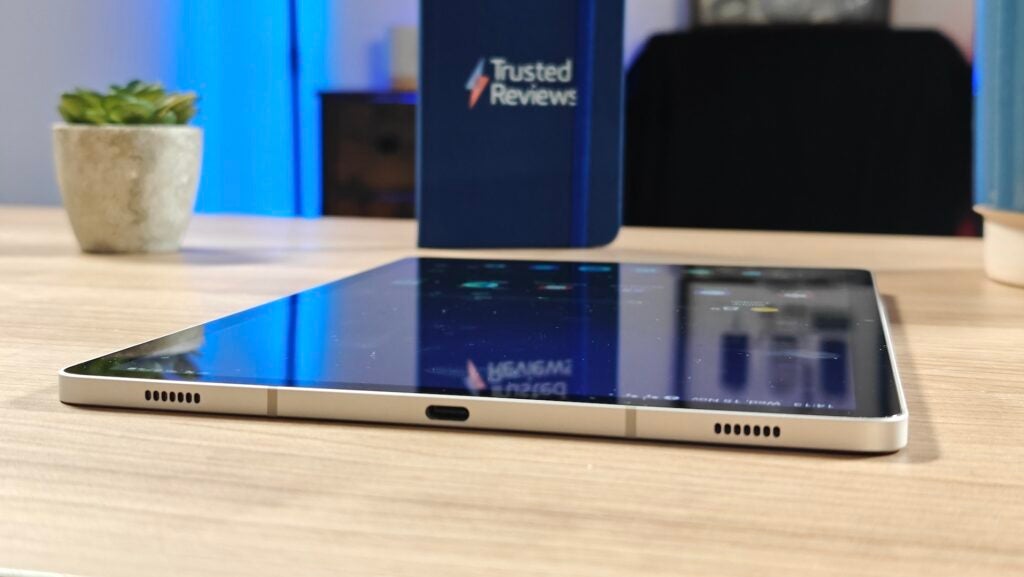
When it does eventually need a top-up, the Galaxy Tab S9 can charge at a rather speedy 45W – the catch is that the charging brick doesn’t come in the box, so you’ll have to supply your own 45W (or higher) charging brick to get the most out of the charging experience.
While I didn’t have an official Samsung 45W charger to hand, I did have a 100W GaN charger that should deliver the maximum charge on offer from the tablet. Using that third-party charger, I saw decent gains of 52% in 30 minutes, with a full charge following in a decent 1 hour and 27 minutes.
It’s not quite the rapid charging of the mid-range OnePlus Pad and its 67W fast charge capabilities, but rather surprisingly, it’s not that far off either.
Should you buy it?
You want an Android tablet with all the bells and whistles
The Galaxy Tab S9 boasts impressive flagship-level tech, from display to processing power, that delivers one of the best Android tablet experiences around.
You want the best app experience possible
Samsung has made waves by bringing previously iOS-exclusive apps to Android, but there are still plenty of apps that don’t fully support the tablet form factor – a stark comparison to Apple’s flawless iPad app integration.
Final Thoughts
Of the entire Galaxy Tab S9 collection, I think the regular Tab S9 offers the sweet spot; it’s premium without being too expensive, and the 11-inch display is big enough to comfortably watch films, doodle with the S Pen and even get a bit of work done, while still being compact enough to easily store in a rucksack. You simply can’t say the same about the even larger S9 Plus and S9 Ultra.
Elsewhere, the Tab S9 doesn’t represent the biggest upgrade compared to last year’s Tab S8, but the upgrades it does have – like upgraded Dynamic AMOLED 2X display tech, IP68 dust and water resistance and the Snapdragon 8 Gen 2 for Galaxy power – make it one of the most capable Android tablets on the market right now.
You certainly won’t find anything on Android more powerful, though it does still lag behind the frankly incredible processing power of Apple’s top-end iPad Pro M2.
For most people, the Tab S9 will deliver everything you need from a tablet – though it does suffer from the same issues as every Android tablet manufacturer; app support. Most of the popular apps are accounted for, but even now, some refuse to load up in a horizontal rotation. That simply doesn’t happen with Apple’s iPad collection.
FAQs
No, despite support for 45W fast charging, you won’t get a charging brick in the box.
With a unique IP68 dust and water resistance rating, the Tab S9 is better equipped than most other tablets on the market.
Yes, you’ll get an S Pen in the box at no extra cost.
















